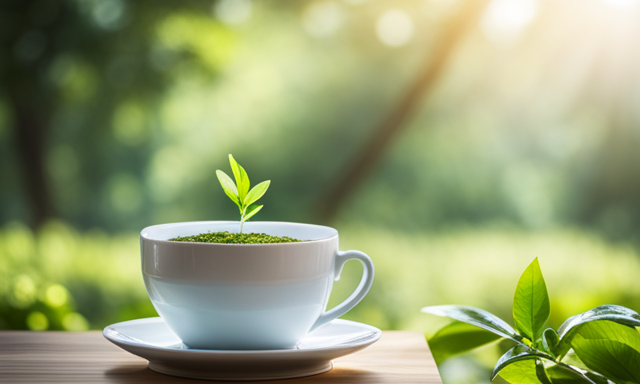What if I told you there was a tea that not only tastes delicious but also offers a plethora of health benefits? Well, let me introduce you to the delightful world of green rooibos.
This incredible tea, derived from the Aspalathus Linearis plant, is a refreshing and nutritious alternative to traditional teas. Unlike its red counterpart, green rooibos undergoes minimal oxidation, retaining its vibrant color and delicate flavor. But what sets green rooibos apart is its impressive nutritional profile, packed with antioxidants, minerals, and vitamins.
From supporting a healthy immune system to promoting digestion, this tea has it all. In this article, we will explore the origins and production of green rooibos, delve into its health benefits, and provide you with tips on how to brew and enjoy this remarkable tea.
So, grab a cup and let’s embark on a journey to discover the wonders of green rooibos.
Key Takeaways
- Green rooibos is derived from the Aspalathus Linearis plant and undergoes minimal oxidation.
- Green rooibos is packed with antioxidants, minerals, and vitamins, supporting the immune system and aiding digestion.
- Green rooibos is caffeine-free and can be enjoyed hot or cold.
- Green rooibos has numerous health benefits, including promoting healthy skin, aiding digestion, and reducing the risk of chronic diseases.
The Origins and Production of Green Rooibos
Get ready to be amazed by the fascinating origins and meticulous production process of green rooibos! The history of green rooibos dates back to the early 20th century in the Cederberg region of South Africa.
This unique variety of rooibos is cultivated from the Aspalathus Linearis plant, which is native to this area. The cultivation process of green rooibos involves carefully selecting the young leaves and stems of the plant. These are then quickly heated to prevent oxidation, preserving the natural green color and delicate flavor. The leaves are then rolled and dried, resulting in the distinctive needle-like shape of green rooibos. This process maintains the high levels of antioxidants and nutrients found in the plant.
Now, let’s explore the difference between green and red rooibos, shall we?
The Difference Between Green and Red Rooibos
Contrasting with its fiery counterpart, the ruby-red rooibos, the green variant showcases a soothing hue reminiscent of a serene meadow at dawn. To fully understand the difference between the two, it’s important to explore the health benefits of green rooibos and the brewing process.
-
Health benefits of green rooibos: This variant is known for its high antioxidant content, which helps combat free radicals and boosts the immune system. It also aids in digestion, promotes healthy skin, and has anti-inflammatory properties.
-
Brewing process of green rooibos: Unlike red rooibos, green rooibos undergoes minimal oxidation, which preserves its natural green color and delicate flavor. It is typically brewed with hot water, similar to other teas, and can be enjoyed hot or cold.
-
Green rooibos is a refreshing and caffeine-free alternative to traditional teas, making it a popular choice for those seeking a healthy and flavorful beverage.
-
Transitioning to the next section on the nutritional value of green rooibos, it’s important to delve deeper into its rich array of vitamins and minerals.
The Nutritional Value of Green Rooibos
Green rooibos is known for its high antioxidant content, making it a valuable addition to a healthy diet. It contains a variety of vitamins and minerals, including vitamin C, calcium, and magnesium. These nutrients contribute to its overall nutritional value and potential health benefits.
Antioxidant Content
With its abundance of antioxidants, green rooibos is like a shield, protecting the body from harmful free radicals. These antioxidants help to combat oxidative stress and reduce the risk of chronic diseases such as cancer and heart disease. Green rooibos contains a variety of antioxidants, including aspalathin, quercetin, and luteolin, which all have their unique health benefits.
Aspalathin has been found to have anti-inflammatory properties, while quercetin supports heart health and luteolin has been shown to have anti-cancer effects. To maximize the antioxidant content of green rooibos, it’s important to brew it properly. Brewing methods, such as using hot water and steeping for at least five minutes, can help to extract the maximum amount of antioxidants.
Moving on to the next section about vitamins and minerals, green rooibos is also a rich source of these essential nutrients.
Vitamins and Minerals
To fully appreciate the benefits of this vibrant tea, you’ll be delighted to discover the plethora of essential vitamins and minerals it contains.
Here are four key nutrients found in green rooibos:
-
Vitamin C: Green rooibos is packed with vitamin C, which helps boost the immune system and protects against potential health risks.
-
Iron: This tea is a great source of iron, which is essential for the production of red blood cells and the prevention of anemia.
-
Calcium: Green rooibos contains calcium, promoting strong bones and teeth, and aiding in muscle function.
-
Potassium: This mineral helps regulate blood pressure and fluid balance in the body.
It’s important to note that while green rooibos is generally safe to consume, it’s always recommended to follow dosage recommendations to avoid any potential health risks.
Transitioning into the subsequent section, the health benefits of green rooibos are truly remarkable.
Health Benefits of Green Rooibos
Imagine yourself feeling refreshed and rejuvenated as you savor the delightful taste and aroma of this vibrant herbal tea, known for its numerous health benefits. Green rooibos has a distinct and mild flavor, offering a refreshing and slightly sweet taste that is enjoyed by many tea enthusiasts.
Not only does it taste great, but it also provides a plethora of health benefits. Green rooibos is rich in antioxidants, which help protect the body against free radicals and reduce the risk of chronic diseases. It’s also known to support a healthy immune system, aid digestion, and promote skin health.
Additionally, green rooibos is caffeine-free, making it a suitable choice for those looking for a natural and soothing beverage. However, it’s important to note that like any other herbal tea, there may be potential health risks associated with excessive consumption.
Now, let’s explore how to brew and enjoy green rooibos, allowing you to fully appreciate its unique qualities.
How to Brew and Enjoy Green Rooibos
When it comes to brewing green rooibos, I find that a few methods and recommendations work best. I prefer using water that’s around 200°F and steeping the leaves for about 5-7 minutes. This allows the delicate flavors to fully develop.
As for pairing with food and other teas, green rooibos goes well with light and fresh dishes, such as salads or grilled vegetables. It also complements other herbal teas, like chamomile or mint, for a refreshing and soothing blend.
Brewing Methods and Recommendations
For the best flavor, steep your green rooibos tea for 5-7 minutes before enjoying a refreshing cup. Green rooibos is delicate and can easily become bitter if steeped for too long. To brew this tea, bring water to a temperature of 180-190°F (82-88°C). Use 1 teaspoon of green rooibos per 8 ounces of water. Place the tea leaves in a tea infuser or strainer and pour the hot water over them. Allow the tea to steep for the recommended time, then remove the leaves. Green rooibos can be enjoyed on its own, but it also pairs well with light and fruity foods, as well as other herbal teas. Now let’s explore how to pair green rooibos with food and other teas.
Pairing with Food and Other Teas
To elevate your tea-drinking experience, explore the delightful combinations of green rooibos with various culinary delights and complementary herbal infusions.
Green rooibos offers a versatile flavor profile that pairs well with a wide range of desserts. Try it with tangy lemon bars for a refreshing contrast or indulge in a decadent chocolate cake to bring out its natural sweetness. For those who prefer fruity flavors, green rooibos pairs beautifully with a berry tart or a tropical fruit salad. To enhance the tea’s earthy undertones, pair it with a nutty dessert like almond biscotti or pistachio macarons. Experimenting with different flavors will reveal unique and surprising taste combinations.
In addition, green rooibos blends harmoniously with other teas such as peppermint or chamomile, adding complexity to your cup.
Now that you know how to pair green rooibos with food and other teas, let’s find out where to find this delightful tea variety.
Where to Find Green Rooibos
When it comes to finding green rooibos, there are a few options to consider. Online retailers and specialty tea shops are a great place to start, as they often have a wide selection of teas available for purchase.
Another option is to check out local markets and tea festivals, where you can often find unique teas that may not be available elsewhere.
Overall, there are plenty of places to find green rooibos, so it’s just a matter of finding the one that works best for you.
Online Retailers and Specialty Tea Shops
While browsing online, one can discover a plethora of specialty tea shops and online retailers that offer green rooibos. These retailers provide a convenient way to explore the world of green rooibos and experience its unique flavor and health benefits. Additionally, many of these online platforms source their green rooibos from local tea farms, ensuring freshness and supporting local communities. To further entice tea enthusiasts, a comparison table is provided below, showcasing a few notable online retailers and specialty tea shops that offer green rooibos.
| Retailer/Shop | Website |
|---|---|
| TeaHaus | www.teahaus.com |
| Art of Tea | www.artoftea.com |
| Adagio Teas | www.adagio.com |
| Harney & Sons | www.harney.com |
Exploring these online options is just the beginning. For those who prefer a more hands-on experience, the next section will delve into the availability of green rooibos at local markets and tea festivals.
Local Markets and Tea Festivals
After exploring the world of online retailers and specialty tea shops, I wanted to delve into a more immersive tea experience. That’s when I discovered the vibrant world of local markets and tea festivals. These events offer a unique opportunity to connect with local market vendors and tea enthusiasts, who are passionate about sharing their knowledge and love for tea.
From the bustling stalls filled with aromatic loose leaf teas to the lively tea tasting sessions, attending a tea festival is a sensory delight. I’ve had the chance to sample a wide variety of teas, learn about different brewing techniques, and even participate in tea ceremonies. These experiences have deepened my appreciation for tea and expanded my understanding of its cultural significance.
Now, let’s delve into the fascinating world of green rooibos in traditional medicine and culture.
Green Rooibos in Traditional Medicine and Culture
Green rooibos, with its vibrant green leaves and delicate flavor, holds a significant place in traditional medicine and culture.
In traditional African medicine, green rooibos has been used to treat various ailments, including allergies, digestive issues, and skin conditions. It’s believed to have anti-inflammatory properties and is often consumed as a tea or applied topically as a herbal remedy.
The cultural significance of green rooibos extends beyond its medicinal uses. It’s considered a symbol of hospitality and is commonly served to guests in South African households. Additionally, green rooibos is an integral part of ceremonies and rituals, representing renewal and purification.
Transitioning into the subsequent section about the sustainability and environmental impact of green rooibos production, it’s important to consider the ways in which this cherished plant is cultivated and harvested.
Sustainability and Environmental Impact of Green Rooibos Production
One cannot underestimate the immense impact of green rooibos production on the environment, as it poses a significant threat to the delicate balance of ecosystems. Sustainable farming practices are crucial in mitigating this impact. Farmers must adopt environmentally friendly techniques such as organic farming, water conservation, and biodiversity preservation to ensure the long-term sustainability of green rooibos production. Additionally, eco-friendly packaging is essential to minimize waste and reduce the carbon footprint associated with the transportation and disposal of products. By using biodegradable materials and reducing packaging waste, the environmental impact of green rooibos production can be further reduced. These practices not only benefit the environment but also contribute to the overall quality and purity of green rooibos products. Transitioning into the subsequent section about frequently asked questions about green rooibos, it is important to address concerns regarding its health benefits and consumption.
Frequently Asked Questions About Green Rooibos
When it comes to brewing green rooibos, there are a few tips that I find helpful. First, I recommend using water that isn’t boiling but rather around 195°F to prevent the leaves from becoming bitter.
Second, steeping the leaves for about 5-7 minutes allows for a full-bodied flavor.
Lastly, storing green rooibos in an airtight container away from light and moisture helps maintain its freshness and potency.
While green rooibos is generally safe for most people, there are a few potential side effects to be aware of. Some individuals may experience stomach discomfort or digestive issues if consumed in large quantities. Additionally, green rooibos contains natural compounds that can act as a diuretic, so it’s important to stay hydrated when drinking it.
Although allergies to green rooibos are rare, some individuals may have sensitivities to certain plants in the legume family, to which rooibos belongs. If you have a known allergy to legumes or experience any allergic reactions like itching, rash, or difficulty breathing, it’s best to avoid green rooibos and consult with a healthcare professional.
Brewing Tips and Storage
To brew the perfect cup of green rooibos, start by placing a heaping tablespoon of the tea leaves into a teapot, allowing them to unfurl and release their vibrant flavors as the hot water is poured over them. Green rooibos requires a brewing time of 5-7 minutes to fully extract its delicate flavors and health benefits. This tea is rich in antioxidants, promoting overall well-being and boosting the immune system. It is also caffeine-free, making it a great option for those looking for a soothing and relaxing beverage. To enhance the taste, you can add a touch of honey or a slice of lemon. After brewing, store the remaining tea leaves in an airtight container away from moisture and direct sunlight to maintain their freshness. Moving on to potential side effects and allergies, it is important to be aware of any reactions one may have to green rooibos.
Potential Side Effects and Allergies
If you’re considering incorporating this herbal tea into your routine, it’s important to be aware of any potential side effects or allergies that may arise. While green rooibos is generally considered safe and well-tolerated, it’s still possible to experience health risks or adverse reactions.
Some individuals may have sensitivities or allergic reactions to rooibos, resulting in symptoms such as itching, skin rashes, or difficulty breathing. If you have a known intolerance to other plants in the Fabaceae family, such as peanuts or soybeans, you may be more prone to allergic responses to rooibos.
It’s also important to note that green rooibos contains natural compounds that may interact with certain medications or have contraindications for individuals with specific health conditions. Therefore, it’s always wise to consult with your healthcare provider before adding green rooibos to your daily routine.
Transitioning to the next section, let’s explore the conclusion: embracing the delightful world of green rooibos.
Conclusion: Embracing the Delightful World of Green Rooibos
So go ahead and dive into the delightful world of green rooibos, and discover a whole new level of tea enjoyment! Green rooibos not only offers a delicious and refreshing beverage, but it also has numerous benefits when used in skincare. Its high antioxidant content helps to protect the skin from damage caused by free radicals, promoting a youthful and radiant complexion.
Additionally, green rooibos can be incorporated into culinary recipes to add a unique and earthy flavor. Whether used in soups, sauces, or desserts, it adds a subtle sweetness and depth to dishes.
Furthermore, green rooibos is caffeine-free, making it a perfect choice for those looking to reduce their caffeine intake. So why not explore the versatility and goodness of green rooibos today?
Frequently Asked Questions
Can green rooibos be consumed by people with specific dietary restrictions or allergies?
Green rooibos is safe for people with specific dietary restrictions or allergies. It is gluten-free and does not contain any nuts, making it suitable for those with gluten or nut allergies.
Is green rooibos suitable for children and pregnant women?
Green rooibos is suitable for children and pregnant women, offering numerous health benefits. It’s gentle on their delicate systems and packed with antioxidants, ensuring optimal health and well-being. Like a nurturing hug for their bodies.
Can green rooibos be used as a natural remedy for common ailments?
Green rooibos can be used as a natural remedy for common ailments. Its high antioxidant content boosts the immune system and its beneficial effects on digestion can alleviate issues such as indigestion and stomach cramps.
How does the taste of green rooibos compare to red rooibos?
The taste of green rooibos is milder and slightly grassy compared to the richer, earthy flavor of red rooibos. Green rooibos also contains antioxidants and minerals that contribute to its health benefits, similar to black tea.
Are there any potential side effects or risks associated with consuming green rooibos?
While green rooibos has potential health benefits, there are minimal known side effects. It is recommended to consume green rooibos in moderation, with a recommended daily consumption of 1-2 cups.
Conclusion
Well, it’s been quite a journey exploring the world of green rooibos! From its origins in South Africa to its production process, we’ve learned so much about this delightful tea.
Not only does green rooibos offer a unique taste compared to its red counterpart, but it also packs a nutritional punch. With its numerous health benefits and rich cultural history, green rooibos is truly a treasure.
So, why not grab a cup, sit back, and transport yourself to a serene oasis? Cheers to embracing the delightful world of green rooibos, my friends!










